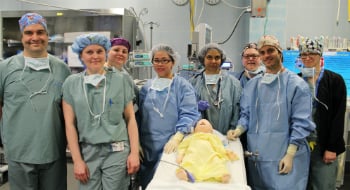
A rare respiratory disease may be more prevalent in Quebec
27 November 2025
Rise in respiratory infections and measles outbreak: important infection prevention measures at the Montreal Children’s Hospital.
Read moreWelcome to the Montreal Children's Hospital

19 February 2015
Heart rates quicken as doctors, nurses, respiratory therapists, and OR aides all crowd around an infant in the Operating Room (OR) at the Montreal Children’s Hospital. A massive bleed has been detected somewhere in her little body and she’s crashing fast. The team has to react quickly or they’re going to lose her. “Time’s up,” calls Dr. Lily Nguyen. The team looks up and takes a deep breath. The 20-minute simulation is over.
Since Spring 2014, the Interprofessional Perioperative Simulation Working Group has been meeting regularly to organize simulations for OR and PACU staff. Dr. Nguyen, a pediatric surgeon and otorhinolaryngologist, and Dr. Rachel Fisher from the Anesthesia department, along with a number of dedicated colleagues, including assistant head nurse Antonietta Carriero, have been leading this program “We get input from our interprofessional working group every step of the way, because we do not want these simulations to be physician-led. Everyone has an equally important part to play,” says Dr. Nguyen.
The group spends over 20 hours organizing each simulation. A real-life scenario is mapped out and then a dry-run rehearsal is conducted at theArnold and Blema Steinberg Medical Simulation Centre (SIM centre) on Parc Avenue, followed by another dry-run at the hospital. Six to seven OR/PACU staff are then invited to take part during rounds on Monday mornings.
The session starts off with a 20-minute preparation course, followed by the 20-minute hands-on simulation, then finishes with a 40-minute de-brief period. During the simulation, staff work on an infant-sized mannequin, one so real-looking they can actually feel, hear and see changes in its behaviour. “It’s real enough that people really get into it,” says Dr. Nguyen. “You can intubate it, hear if there’s an obstruction in its breathing and even see its pupils dilate.” During the simulation, engineers from the SIM centre can manipulate the mannequin’s breathing, heart rate and blood pressure, among other vital functions.
To date, eight simulations have already been completed, and two more have been scheduled before the Children’s moves to the Glen. “When developing these scenarios we try to create crisis situations where a patient is deteriorating quickly and needs help from a number of different people,” explains Dr. Nguyen. “Simulation is a safe environment where we can make mistakes and learn from them. There is no judgment of people’s competence or marking of their performance. This is all about learning, team building and improving communication. By practising regularly, together as a team, we are aiming to provide the highest quality and safest care to our patients. ”
The simulations have also helped the OR team identify system-based issues in the OR. After every session, the team looks at what went well and what could be improved. The detected issues are then noted and brought to the attention of the Perioperative Committee. “To date, every change we have suggested has been implemented,” says Dr. Nguyen. During a recent simulation, a mock code was called and the team noticed ICU staff would take a while to change out of their regular clothes and into scrubs. So the group came up with a solution. Why not leave emergency zippered jumpsuits right outside the doors to the OR? It’s a simple solution that could save valuable seconds in an emergency situation.
The working group is also planning to set up an official simulation committee for both adult and pediatric hospitals once the Glen site is open. Since many errors occur during transport, their ultimate goal is to develop a scenario where the patient must be moved between different departments throughout the Children’s. “We would like to make these simulations hospital-wide by setting up simultaneous simulations in the Emergency department, OR, and Intensive Care units,” says Dr. Nguyen. “We work together in real life, so it makes sense to practice together in simulation.